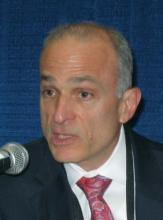SAN FRANCISCO – Selected patients with ST-elevation myocardial infarction fare just as well with a treatment strategy of early fibrinolysis followed by transfer to a PCI center for timely coronary angiography as they do with primary PCI, according to the landmark STREAM trial.
The large patient population for whom this so-called "pharmacoinvasive" or fibrinolysis-first strategy is applicable comprises those STEMI patients whose symptoms are less than 3 hours old at first medical contact and who cannot undergo primary percutaneous coronary intervention (PCI) within the following hour, Dr. Frans Van de Werf explained in presenting the results of the STREAM (Strategic Reperfusion Early After Myocardial infarction) trial at the annual meeting of the American College of Cardiology.
Guidelines are clear that primary PCI is the preferred reperfusion method in STEMI patients with recent onset of symptoms, but only when the intervention can be performed promptly by an experienced team. That’s a huge caveat. The fact is that primary PCI doesn’t get done within guideline-recommended times for most patients who present to a non–PCI-capable hospital. Large registries consistently show this to be the case because of lengthy transfer times and other logistic issues, noted Dr. Van de Werf, professor of cardiology at the Catholic University of Leuven (Belgium).
"This study is not a challenge to primary PCI, it’s a study in a population who can’t get primary PCI in a short period of time," he stressed.
STREAM was an international, prospective, randomized trial involving 1,892 STEMI patients who presented to a non-PCI center within 3 hours of symptom onset and were unable to undergo primary PCI within the next hour. They were randomized to direct transfer for primary PCI or to fibrinolytic therapy with tenecteplase along with clopidogrel and enoxaparin, followed by transfer to a PCI-capable center.
If an ECG obtained 90 minutes after bolus tenecteplase showed at least 50% ST resolution, patients underwent coronary angiography 6-24 hours later – after the increased procedural bleeding risk associated with fibrinolytic therapy had worn off – with PCI or coronary artery bypass graft (CABG) surgery if indicated. However, if the ECG did not show reperfusion, emergency angiography was performed with an eye toward PCI.
The median time to the start of reperfusion therapy was 100 minutes from symptom onset in the pharmacoinvasive group, compared with 178 minutes in patients assigned to primary PCI.
The primary study endpoint was the 30-day cumulative rate of death, shock, congestive heart failure, or reinfarction. It occurred in 12.4% of the fibrinolysis-first group and 14.3% of those who underwent primary PCI, a nonsignificant difference (P = .21).
The ECG showed that fibrinolysis failed, requiring emergency angiography, in 36% of patients, with rescue PCI performed an average of 2.2 hours after randomization. The other 64% of patients in the pharmacoinvasive group underwent nonurgent catheterization at a median of 17 hours.
"The study results provide the opportunity for a measured approach to invasive coronary interventions, circumventing an urgent procedure in about two-thirds of fibrinolytic-treated STEMI patients," Dr. Van de Werf observed. "Drug therapy before transfer is at least as effective as PCI, and an urgent catheterization was avoided in two-thirds of patients. This gives physicians time to consider other options, such as CABG and medical therapy."
Indeed, CABG was significantly more frequent in the pharmacoinvasive strategy group than with primary PCI, by a margin of 4.7% to 2.1%. As CABG is probably a better revascularization procedure, this is a good thing, the cardiologist continued.
Intracranial hemorrhage occurred significantly more frequently in the fibrinolysis group than with primary PCI, by a margin of 1.0% to 0.2%. However, after one-fifth of STREAM participants had been enrolled, investigators realized that those aged 75 years or older had an excess risk of intracranial hemorrhage with full-dose bolus tenectaplase. Thereafter, the tenectaplase dose was reduced by 50% in elderly patients. It’s worth noting that in the more than 1,500 patients enrolled after the dosing adjustment, the intracranial hemorrhage rate was similar in both study arms and the fibrinolysis-first group’s lower rate of the study’s primary composite endpoint nearly reached statistical significance, Dr. Van de Werf said.
Probably as a result of earlier recanalization in the fibrinolysis group, their rate of heart failure was 6.1%, compared with 7.6% with primary PCI. Cardiogenic shock was also less common in the fibrinolysis group, by a margin of 4.4% to 5.9%.
"These are important observations. They were not statistically significant differences, but nonetheless I think we might see an effect on long-term mortality. So we are collecting long-term mortality data," he continued.



